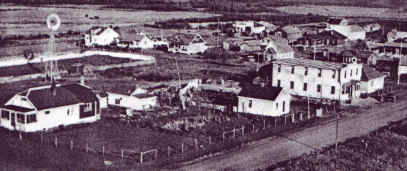

| HOME | LOTS FOR SALE | CONTACT US | BUSINESS DIRECTORY | COMMUNITY PHOTOS | LINKS |
| VILLAGE INFO | UPCOMING EVENTS | COME AND VIEW OUR MUSEUM | CHUCKWAGON INFO | FEATURED EVENTS | MEMORIAM |
| FIRE DEPARTMENT | NEWSLETTER |
Few things are more important during an emergency than clean, fresh water. Knowing how to purify water is an invaluable skill that can save your life in a crisis.
There are three main ways to purify water: Boiling, Filtration, and UV Light. Each method has its own advantages and disadvantages.
Boiling is one of the simplest ways to make water safe to drink. By bringing water to a full rolling boil for 1-3 minutes it kills any bacteria, viruses or parasites that are present. This method does not remove harmful chemicals or heavy metals though.
As the water boils it transforms from a liquid into steam and vapour. This change in physical properties also impacts the taste of the water making it flat, however this can be overcome by pouring boiled water between clean containers several times.
Alternatively, chemical disinfectants can be used to purify water. Unscented household chlorine bleach (chlorine dioxide tablets are another option) can be added to a water source to make it safe to drink. Disinfectants* kill most harmful or disease-causing bacteria and viruses. However, they are not as effective against the more resistant organisms like Giardia and Cryptosporidium.
Water filters can clean your water at home, reducing chemicals and bacteria to make it safe for drinking. They remove bad odors and tastes to give you fresh, delicious-tasting water. Filters also reduce contaminants that cause gastrointestinal problems like parasites and germs. They can even lower your risk of cancer by removing chlorine and other chemicals from the water you drink.
Water filtration systems can also filter out minerals that contribute to hard water. This type of water can corrode pipes, shorten the lifespan of appliances and cause staining on dishes, clothes and skin.
You can use bleach tablets or liquid to purify water with a chemical method. You'll need to add 6-8 drops of bleach per gallon (or 2 drops per liter) of water. This will kill bacteria and other pathogens. However, this method can leave toxic residue on surfaces and can leave a foul taste in your mouth. The most popular water filters on the market use activated carbon, which has a high-efficiency rate for removing these contaminants from your drinking water.
Water can be purified using UV radiation from a mercury vapor lamp or sterilization light. This method can eliminate any microorganisms, but it does not remove other contaminants such as lead, salts and metals.
UV disinfection works best with clear, clean water. If the water is cloudy, allow it to settle and filter through a clean cloth or coffee filter before boiling. It’s important to store the boiled water in clean, sanitized containers with tight lids.
Unscented, regular household chlorine bleach can also be used to disinfect water. Read the label carefully to ensure you’re using the correct concentration. It’s also effective against most harmful bacteria and viruses including cryptosporidium (a parasite responsible for Montezuma’s revenge), which is resistant to the chlorine that city water is treated with. This treatment also does not remove chemical contamination or sediment from the water. However, it can be a good option in an emergency situation.
Water is a crucial element for many activities in life and must be free from harmful impurities. Purified water is required for medical procedures, scientific research and industrial processes. It is essential that everyone knows the different methods of ensuring safe and clean drinking water at home and outdoors.
Using chemicals is a quick and easy way to disinfect your water, as long as you know how to do so safely. Chlorine is a powerful chemical that kills germs and parasites in water. You can buy chlorine liquid or tablets off the shelf, but be sure to follow label instructions and do not use this method if you have thyroid problems or are pregnant.
Iodine is another quick and simple chemical that can disinfect water by killing disease-causing germs. You can use iodine tablets, available in most stores or make your own solution by adding a few drops of 2% iodine to a gallon of water.
 |